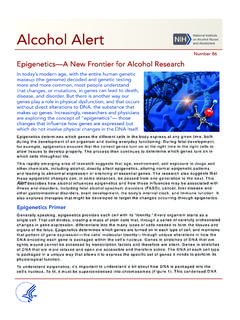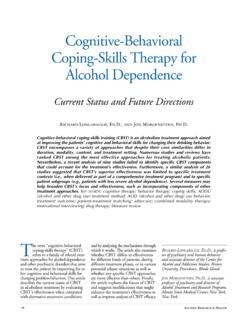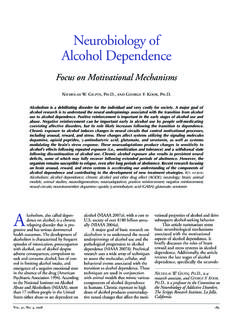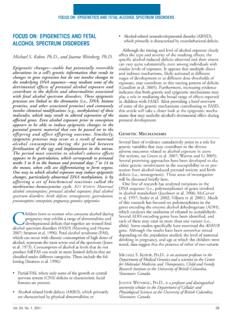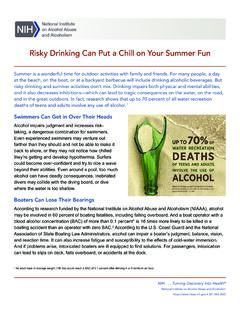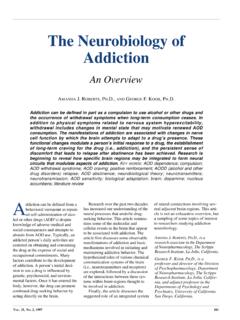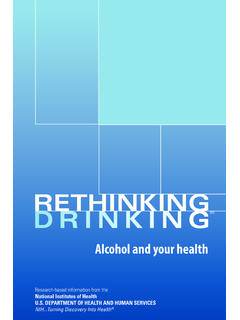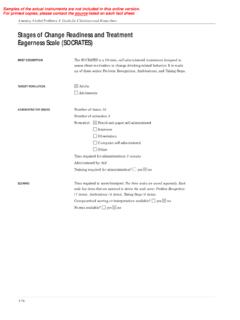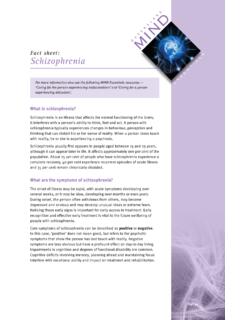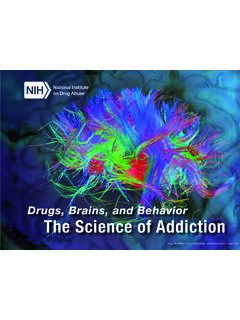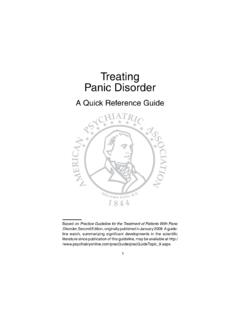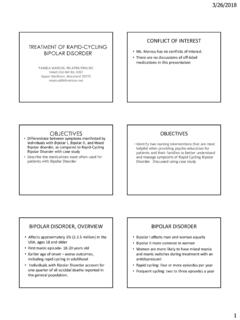Transcription of What Is Craving? - National Institutes of Health
1 What Is Craving? Models and Implications for TreatmentRaymond F. Anton, many alcoholics experience craving, researchers have not yet developed acommon, valid definition of the phenomenon. Numerous models of the mechanismsunderlying craving have been suggested, however. One of those models the neuroadaptivemodel suggests that the prolonged presence of alcohol induces changes in brain-cellfunction. In the absence of alcohol, those changes cause an imbalance in brain activity thatresults in craving. Furthermore, the adaptive changes generate memories of alcohol spleasant effects that can be activated when alcohol-related environmental stimuli areencountered, even after prolonged abstinence, thereby leading to relapse. Similarly, stressfulsituations may trigger memories of the relief afforded by alcohol, which could also lead torelapse.
2 Neurobiological and brain-imaging studies have identified numerous brain chemicalsand brain regions that may be involved in craving. Psychiatric conditions that affect some ofthese brain regions, such as depression or anxiety, also may influence craving. A betterunderstanding and more reliable assessment of craving may help clinicians tailor treatment tothe specific needs of each patient, thereby reducing the risk of relapse. KEY WORDS: AOD(alcohol and other drug) craving; neurobiological theory; biological adaptation; reinforcementfactor; AOD abstinence; AODD (alcohol and other drug dependence) relapse; brain function;scientific model; specific AODU (alcohol and other drug use) measurement and test;evaluation; treatment; literature reviewVol. 23, No. 3, 1999165 Many alcoholics, includingthose trying to achieve absti-nence, experience craving foralcohol, often for extended periods oftime.
3 Jellinek and colleagues (1955)first recognized craving as a centralcomponent of the alcohol dependencesyndrome. Up until the 1990s, how-ever, other researchers and cliniciansdid not rigorously investigate this phe-nomenon. Only during the past 5 to10 years has interest in craving increased,fueled to various extents by numerousdevelopments, as follows: Cognitive psychology, which hasplayed an increasingly importantrole in the investigation and treat-ment of alcoholism, emphasizes theneed for understanding, monitoring,and using alcohol craving as part ofa structured alcoholism treatmentapproach (Marlatt and Gordon 1985). Researchers and clinicians have re-evaluated classical conditioning1as a mechanism that may underlie adrinker s response to alcohol-relatedstimuli, or cues, in the environment( , the smell of beer or the sightof a bar); as a result, researchershave developed hypotheses andexperimental approaches related tocue-induced craving (Cooney et ; Monti et al.)
4 1987). Medications such as naltrexone havebeen found to reduce relapse amongRAYMONDF. ANTON, , is a professorof psychiatry and director of research atthe Center for Drug and Alcohol Programs,Alcohol Research Center, MedicalUniversity of South Carolina, Charleston,South work was supported in part byNational institute on Alcohol Abuse andAlcoholism grants RO1 AA 09568 andP50 AA a definition of this and other technical termsused in this article, see the glossary, p. alcoholics, and some stud-ies suggest that these medicationsalso may reduce craving (O Malleyet al. 1992; Volpicelli et al. 1992;Anton et al. in press). Researchers have greatly expandedthe understanding of the brain mech-anismsunderlying alcohol and otherdrug (AOD) dependence and of thebrain structures that may be associ-ated with craving (Grant et al. 1996;George et al. 1999).
5 Researchers and clinicians havedeveloped improved instruments forassessing the severity of craving; thesenew rating scales have greater reliabil-ity in measuring and defining crav-ing (Anton et al. 1995; Bohn et ; Singleton et al. 1995). The methods used in alcoholismtreatment research have becomeincreasingly sophisticated; as a result,the relationship of concepts such ascraving to clinical outcome now canbe reliably evaluated (Roberts et ; Flannery et al. 1999).Despite the renewed interest in crav-ing, researchers and clinicians have notyet developed a common definition ofthe phenomenon or identified its under-lying causes because craving is primarilya subjective experience for each a valid, uniform definition ofcraving, however, clinicians cannotaccurately assess their clients levels ofcraving or measure changes in cravingthat might indicate an improvement or worsening in the client s lack of a definition of craving alsoimpedes researchers in their investigationsof the neurological and psychologicalmechanisms contributing to the experi-ence of craving.
6 A better understandingof those mechanisms, in turn, couldlead to improved behavioral and phar-macological approaches for the treat-ment of article reviews various modelsof craving that researchers have developedin recent years to explain the clinicalphenomenon and underlying mecha-nisms of craving. In addition, this articledescribes the brain networks that havebeen associated with craving as well asthe approaches used to measure crav-ing. Finally, the article summarizes theclinical implications of an improvedevaluation of craving and provides anoutlook on future craving of Alcohol CravingAlthough the concept of craving appearsto be central to the understanding ofaddiction to all AODs particularly to the loss of control over and relapseto AOD use precise definitions ofcraving have remained elusive (Ludwigand Stark 1974; Kozlowski and Wilkin-son 1987; Kozlowski et al.)
7 1989;Sitharthan et al. 1992). Similarly, noagreement exists among researchers andclinicians on how to measure cravingaccurately. Nevertheless, investigatorshave made substantial progress indeveloping numerous models of AODcraving (for reviews, see Singleton andGorelick 1998; Anton and Drobes1998). Singleton and Gorelick (1998)have developed a classification schemethat comprises two general categoriesof craving models: (1) models based onconditioning mechanisms ( , condi-tioning models) and (2) models basedon cognitive mechanisms ( , cogni-tive models) (see table, p. 167).Conditioning models are based onthe tenets of classical tenets posit that alcohol-relatedcues ( , the sight of a bar or a beerbottle), after repeatedly being pairedwith alcohol consumption, becomeconditioned stimuli that is, they elicitthe same physiological and psychologicalresponse as alcohol consumption itself( , release of certain brain chemicals[ , neurotransmitters]).
8 If alcoholconsumption does not occur immedi-ately, these cue-induced responsesresult in craving, either to experiencealcohol s pleasant, or reinforcing, effectsor to avoid or alleviate the unpleasant,or aversive, effects of not , cognitive models are basedon the assumption that responses toalcohol and alcohol-related cues involvevarious cognitive processes, such asexpectations regarding the pleasanteffects of alcohol and a person s beliefin his or her own ability to cope withthe desire to drink. Although some ofthese models may be more relevant todrugs other than alcohol, many charac-teristics (and, consequently, models) ofcraving overlap among various their differences, all cravingmodels assume that alcohol craving is amultifaceted phenomenon that is influ-enced by a variety of factors. Further-more, animal experiments suggest thatcraving may be associated with certainbrain regions ( , neuroanatomy) andneurotransmitters ( , neurochemistry).
9 These relationships, however, have notyet been described in detail, and betterclinical and laboratory models of crav-ing are needed to address those models likely will improve under-standing of the neuroanatomical pro-cesses involved in craving, as well as ofcraving s role in abstinence and relapse,and may ultimately lead to improvedpsychosocial or pharmacological treat-ment approaches for researchers and cliniciansagree that a greater understanding of allaspects of craving is necessary in orderto improve treatment. Models thatattempt to merge psychological, behav-ioral, and brain mechanisms may bemost useful for fostering the formula-tion and evaluation of new theories oncraving. The next section discusses onesuch model, which attempts to explaincraving in the context of phenomenafrequently observed by many aspects of this modelremain speculative and more data areneeded to support the concepts described,the model can help researchers linkspecific neurochemical systems to theprocesses that underlie the manifesta-tion of Neuroadaptive Model of CravingScientists believe that a gradual and,perhaps, permanent adaptation ofbrain function ( , neuroadaptation)to the presence of alcohol is a centralfeature in the development of alcoholdependence (Robinson and Berridge1993; Koob and Le Moal 1997).
10 Long-term alcohol consumption interfereswith many brain functions. Becausethe body, including the brain, must166 Alcohol Research & Health maintain a balanced state ( , home-ostasis) with respect to critical bodilyfunctions ( , blood pressure, bodytemperature, and communicationamong cells), many cells includingnerve cells ( , neurons) in the brain adapt their activities in response to theprolonged presence of alcohol. Thisneuroadaptation, or sensitization, leadsto certain characteristics of alcohol depend-ence, such as tolerance and withdrawal,as well as to a condition that might becalled reward memory (see figure 1, ), a memory that has its roots incertain brain cells and is dependent onchemical changes in those cells. The reward memory, which may be uncon-scious, gives heightened attention, orsalience, to environmental cues that arecommonly paired with alcohol ( , thesmell of alcohol or the sight of a beerbottle) or to alcohol consumption likely occurs to agreater extent and more permanentlyin people who are at increased risk fordeveloping alcoholism, either becausethey have inherited a genetic predispo-sition from their parents or becausethey have acquired such a susceptibilitythrough repeated experiences of severestress.

